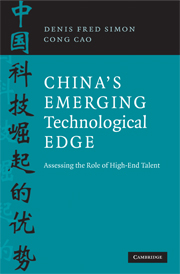Book contents
- Frontmatter
- Contents
- List of Figures and tables
- Acknowledgements
- Abbreviations
- Introduction
- 1 Human resources, technological innovation, and economic growth
- 2 China's talent challenge
- 3 Human resources in science and technology, and their structure and characteristics in China
- 4 Higher education and scientists and engineers in the pipeline
- 5 Utilization of scientists and engineers in China
- 6 “Brain drain,” “brain gain,” and “brain circulation”
- 7 Supply and demand of science and technology talent in China: key drivers
- 8 China's talent in key emerging technologies
- 9 Whither China's talent pool?
- Appendix: Understanding Chinese science and technology human resources statistics
- References
- Index
2 - China's talent challenge
Published online by Cambridge University Press: 25 January 2011
- Frontmatter
- Contents
- List of Figures and tables
- Acknowledgements
- Abbreviations
- Introduction
- 1 Human resources, technological innovation, and economic growth
- 2 China's talent challenge
- 3 Human resources in science and technology, and their structure and characteristics in China
- 4 Higher education and scientists and engineers in the pipeline
- 5 Utilization of scientists and engineers in China
- 6 “Brain drain,” “brain gain,” and “brain circulation”
- 7 Supply and demand of science and technology talent in China: key drivers
- 8 China's talent in key emerging technologies
- 9 Whither China's talent pool?
- Appendix: Understanding Chinese science and technology human resources statistics
- References
- Index
Summary
Ironically, even as the numbers concerning China's production of new scientists and engineers have continued to rise in a dramatic fashion, there have been conflicting perceptions about the actual talent situation in China. On one hand, as noted in the Introduction, as spending on science and technology (S&T), research and development (R&D), and education has been growing at an accelerated rate, not surprisingly, large increases in the size of the country's overall talent pool have occurred as well. At present, China's overall S&T talent pool is the largest in the world, and the number of scientists and engineers in China is the world's second largest. Moreover, the evolving pipeline seemingly remains full as Chinese universities graduate the world's largest number of students. On the other hand, complaints continue to proliferate from multiple segments of the economy and society – from Chinese government officials to enterprise chief executive officers (CEOs), including the country heads of most multinational corporations (MNCs) that operate in China – about the problems that plague the local talent pool: demand seems to be exceeding supply; quality problems are rampant; and the talent already in place remains difficult to manage and retain.
Indeed, China faces a serious talent challenge as it seeks to sustain domestic economic growth and technological advance. The active members of its professional community are young when compared with their counterparts in the West – many being fresh out of school – so that they lack the concomitant experience of their peers abroad, especially in many leadership positions in the Chinese research system.
- Type
- Chapter
- Information
- China's Emerging Technological EdgeAssessing the Role of High-End Talent, pp. 22 - 56Publisher: Cambridge University PressPrint publication year: 2009
- 1
- Cited by



